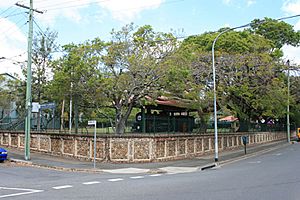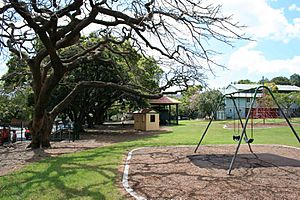Bedford Playground facts for kids
Quick facts for kids Bedford Playground |
|
|---|---|

Bedford Playground, 2008
|
|
| Location | 8 Love Street, Spring Hill, City of Brisbane, Queensland, Australia |
| Design period | 1919 - 1930s (interwar period) |
| Built | 1927 onwards |
| Architect | Frank Gibson Costello |
| Official name: Bedford Playground, Bedford Park, Spring Hill Playground | |
| Type | state heritage (landscape) |
| Designated | 9 May 1998 |
| Reference no. | 601786 |
| Significant period | 1920s (historical) 1920s-1940s (fabric grounds, planning) 1920s ongoing (social) |
| Significant components | hall, playground, garden - rock / rockery, trees/plantings |
| Builders | Manuel Hornibrook |
| Lua error in Module:Location_map at line 420: attempt to index field 'wikibase' (a nil value). | |
The Bedford Playground is a special park for kids in Spring Hill, Brisbane, Australia. It is located at 8 Love Street. This playground is very old and important, so it is listed on the Queensland Heritage Register.
It was designed by Frank Gibson Costello. Building started in 1927. One of the builders was Sir Manuel Hornibrook. People also know it as Bedford Park or Spring Hill Playground.
Contents
History of Bedford Playground
The Bedford Playground opened in 1927. It was the third playground created by the Playground Association of Queensland. In 1959, the park was named after Ms Josephine Mary Bedford. She was a kind person from Brisbane who helped families. She was also a very important member of the Playground Association.
Why Playgrounds Were Built
The Playground Association of Queensland started in 1913. They wanted to create public parks and playgrounds, like those in the United States. A book from 1909, Playground Technique and Playcraft, guided their ideas. It said that children needed good food, fresh air, sunshine, and exercise to be healthy. Playgrounds provided air, sunshine, and exercise. They also taught kids to love nature.
Early playgrounds in America were often part of big parks. These parks sometimes had gyms, running tracks, and buildings with halls or libraries. Famous landscape architect Frederick Law Olmsted designed many of these. He also helped design Central Park, New York.
Playgrounds in Queensland
In Queensland, the playgrounds were smaller. They focused only on children. They usually had a playground and a "field house." This was a building for supervisors and activities. These playgrounds were often near kindergartens. This was because Mary Josephine Bedford was also involved with the Crèche and Kindergarten Association. This group helped poor children in Brisbane.
Mary Josephine Bedford worked hard to help people. She traveled to America and Europe to learn about family welfare. She learned about public parks in 1911. She helped the Brisbane Children's Hospital in 1905. She also helped start the Queensland branch of the National Council of Women of Australia. During World War I, she served in Serbia as an ambulance driver. She was active in both associations until she passed away in 1955.
How Playgrounds Helped Kids
The Playground Association wanted to build playgrounds in busy, poorer areas. They also wanted to manage the parks. They hired trained supervisors. These supervisors would guide play and teach children good values. They also looked after playground libraries. The Association believed play helped children learn and grow.
The first three playgrounds were in Paddington (1918), Fortitude Valley (1922), and Spring Hill (1927). All these areas had many low-cost homes. The playground sites were often unused land. For example, the Spring Hill playground was built on an old quarry.
These playgrounds were near schools and swimming pools. They had important features. They had fences for safety. They had separate areas for boys, girls, and toddlers. They also had a field house. These playgrounds were models for other schools and councils to copy.
The Spring Hill Quarry Site
The Spring Hill Playground was built on an old quarry site. From the 1860s, this quarry provided stone for buildings in Brisbane. The stone is called porphyry. It is formed from volcanic ash. The quarry closed in the early 1900s.
In 1924, the Brisbane City Council received the land for a park. The Playground Association agreed to manage it. The Spring Hill Playground officially became a children's playground reserve in 1924. More land was added later, making the playground bigger.
Changes Over Time
Early plans show the playground had three main sections. Boys were near Love Street, girls near Quarry Street, and infants in the middle. A field house with a free library was also there. It was an old timber cottage moved to the site. Fences were added in 1935 for more safety.
In 1945, a war memorial hall was opened. It was designed by the City Architect. It honored those from Paddington, Spring Hill, and Fortitude Valley who served in World War II. The original supervisor's cottage burned down in 1959. The insurance money helped build a library under the Memorial Hall.
Mary Josephine Bedford died in 1955. To remember her, a memorial tree was planted at the Spring Hill Playground in 1956. In 1959, the park was officially renamed the Bedford Playground in her honor.
Some parts of the park were later used for other community centers. These include the Shaftsbury Citizenship Centre and the Lady Gowrie Occasional Child Care Centre.
What Bedford Playground Looks Like
Bedford Playground is a large open space. It has tennis courts, play equipment, and an old steam train. There is also a large rock outcrop that was once a quarry. The park is surrounded by Water, Love, and Quarry Streets.
You can enter the playground from Love Street. A tall chain-link fence surrounds the park. Near the entrance, there is a stone wall with "BEDFORD PLAYGROUND" written on a steel sign.
Inside the playground, there is a large hall. It has a gabled roof. The building has many windows. You enter it by a timber staircase.
The Old Quarry
The most noticeable part of the playground is the large rock outcrop. It is in the southern corner of the park. Many trees and plants grow around and on the stone. You can see where the stone was cut. A plaque on the rock says, "BRISBANE CITY COUNCIL: THIS QUARRY IS PRESERVED FOR ITS GREAT GEOLOGICAL INTEREST." There is also a winding concrete stair cut into the rock. It leads to a path and an old lookout.
Play Areas and Other Features
The central part of the playground has modern play equipment made of metal, plastic, and timber. There is also a small playhouse called the Betty Mansion. It looks like a miniature two-story house. Some old concrete slabs show where earlier play equipment used to be.
A tennis court is on a raised area next to the rock outcrop. An old steam locomotive is in one corner of the park. It is surrounded by a steel fence.
Many large, old trees grow around the playground. They provide shade and privacy.
Why Bedford Playground is Special
Bedford Playground was added to the Queensland Heritage Register on 9 May 1998. This means it is an important historical site.
Important to Queensland's History
The playground shows how inner-city suburbs like Spring Hill grew. It also shows how people in the early 1900s thought about caring for children. They believed playgrounds helped kids in poorer areas have a better future. The park also has an old quarry from the 1860s. This shows Brisbane's early building history. It is also a rare example of "untamed" nature in the city.
Unique and Important Features
The playground is a good example of early model playgrounds. These were created by the Playground Association of Queensland. They were inspired by American playgrounds. You can see this in the park's layout, the memorial hall, the Betty Mansion, and the old trees.
Beautiful and Interesting
The park is a beautiful open space in Spring Hill. The old quarry is especially interesting. It looks natural and bold, standing out from the buildings around it.
Special to the Community
The playground is very important to the local community. It is a well-known public park and a supervised playground for children.
Linked to Important People
Bedford Playground has a special connection to Ms Mary Josephine Bedford. She was a kind person from Brisbane who helped many families. She was very important in starting playgrounds and childcare centers in Brisbane.


